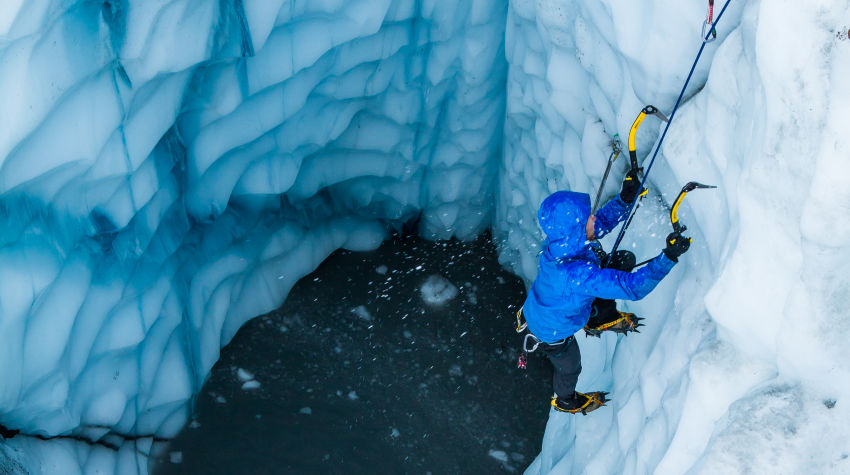Why is Glacier Ice Blue

Exploring Blue Ice
The Matanuska Glacier is an incredible feature of our natural environment located in central southern Alaska. The terminus is located in Glacier View, Alaska, right where the MICA Guides Base is located. On the MICA base, we have an incredible view of the white and blue ice that extends for 27 miles back into the valley.
The Deep Blues

A group of climbers explores the remote area of a water filled moulin farther back on the glacier.
Photo Credit: David Crane
To get an even better view of the deep blues, take a ride in our helicopter on a scenic flight over the ice, or touch down and explore with our Helicopter Glacier Hike. From any point of view, the glacier’s blue coloring is still visible. Our guides often get asked, “What makes the glacier ice blue?” The varying shades of cerulean, turquoise, and deep blues within the Matanuska Glacier capture our eyes. They seem to instill a sense of awe within all those who observe it from above or below the glacier’s surface.
The Matanuska Glacier formed over many years by accumulating snow faster than the snow could melt. This excess snow compacts into ice over time and becomes heavy enough to start to move with the force of gravity. The deepest layers begin to deform due to the weight of the snow and ice above it.
Seeing Blue
Since the ice in the glacier is so dense, it absorbs the long wavelengths that make up the red part of white light, and the short wavelengths that make up the blue light are transmitted and scattered. Basically, the dense ice of the glacier absorbs every color in the spectrum except blue. And so blue is the color we see.
Bluer ice means that the light had to travel on a longer path in the ice. It is a denser ice. This is why snow appears to be white, and not blue. Light does not penetrate into snow far enough before it is scattered back to the observer. Also, there are more air bubbles in snow than in glacial ice, and these air bubbles scatter the light.
Glacial ice has a crystalline structure, which strongly scatters blue light. The ice has been strongly compacted for many years, so it has a different structure than the ice in your freezer. The glacier is made of more than just water and frozen snow, it also contains small pieces of rock and soil. These particles were accumulated as the glacier slowly moved through the valley, carving out the surrounding rock.
Glacier Views from a Helicopter
In the helicopter, you can see the glacier’s path between the mountains that it formed thousands of years ago. The bluest ice on the glacier is the coarse-clear ice found near the terminus (end) and near the margins (sides). This ice does not have any air bubbles, and therefore reflects the most blue light.
On overcast days, the ice appears a lot bluer than on sunny days. This is because there is less light to be reflected by the upper ice layers, making the blue in the deeper layers more visible. Regardless of the sun’s intensity, a bird’s eye view of the glacier in a helicopter is impossible to beat. It is the only way to observe all parts of the glacier and to discover new features, such as a newly formed glacier cave.

This crevasse reveals the thick blue ice that exist below the white ice.
Photo Credit: David Crane
With our Ultimate Helicopter Adventure Tour, you will fly over the glacier and be dropped off with a guide in a remote location with unknown features. Glacier caves are a rare feature and are difficult to come across, as they are uncommon and quite dangerous, but they do exist. Inside of a glacier cave, the walls are dark blue. This is because there is not a lot of light that can reach the ice at that depth.
The only light that can be seen is the blue light, since it is being reflected by the ice’s crystalline structure. Even if there are no glacier caves accessible on the glacier, you can still witness the spectacular dark blues by peering into an empty moulin or a deep crevasse. Explore the wonders and colors of the Matanuska Glacier and experience an environment like no other with MICA Guides.
